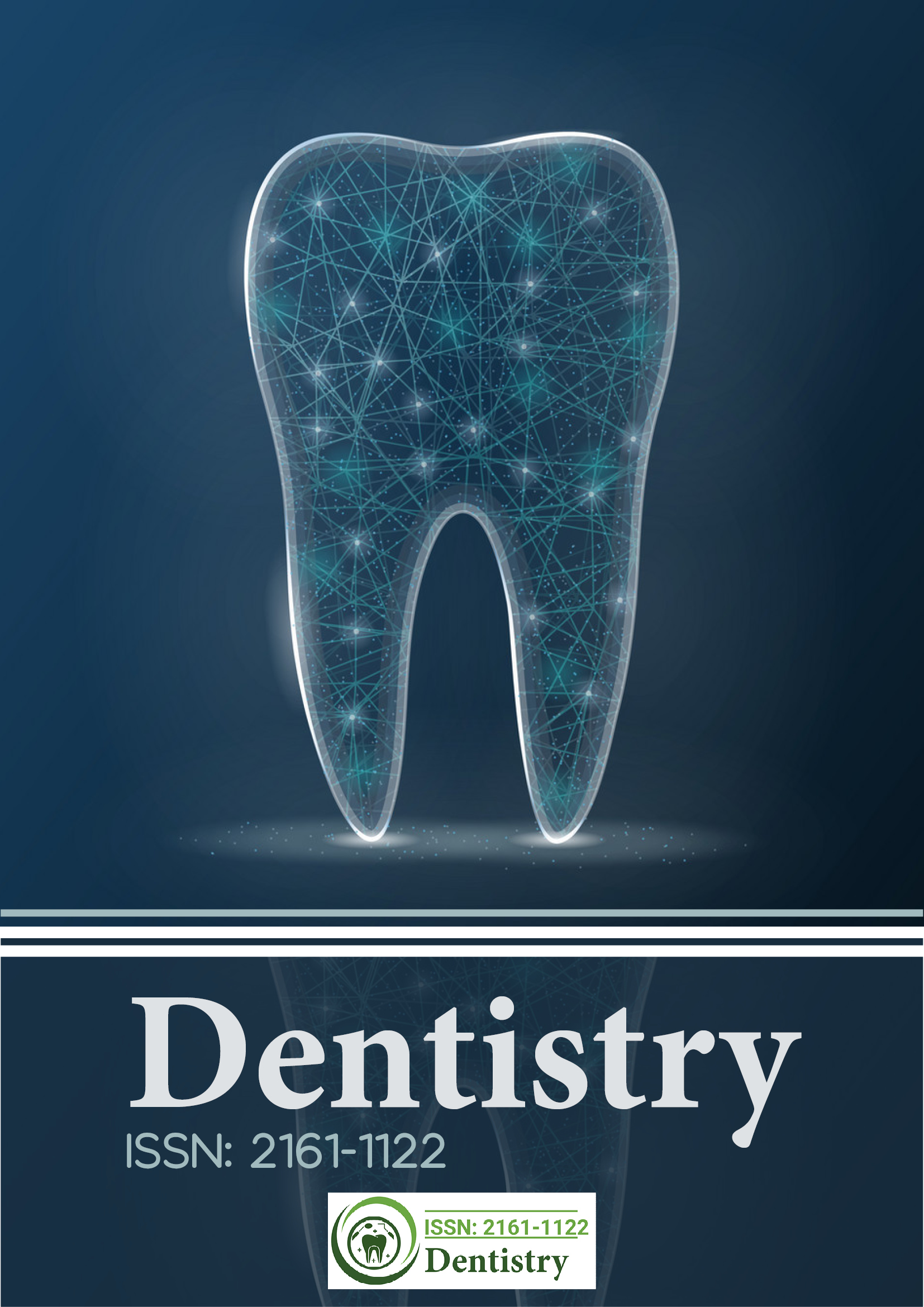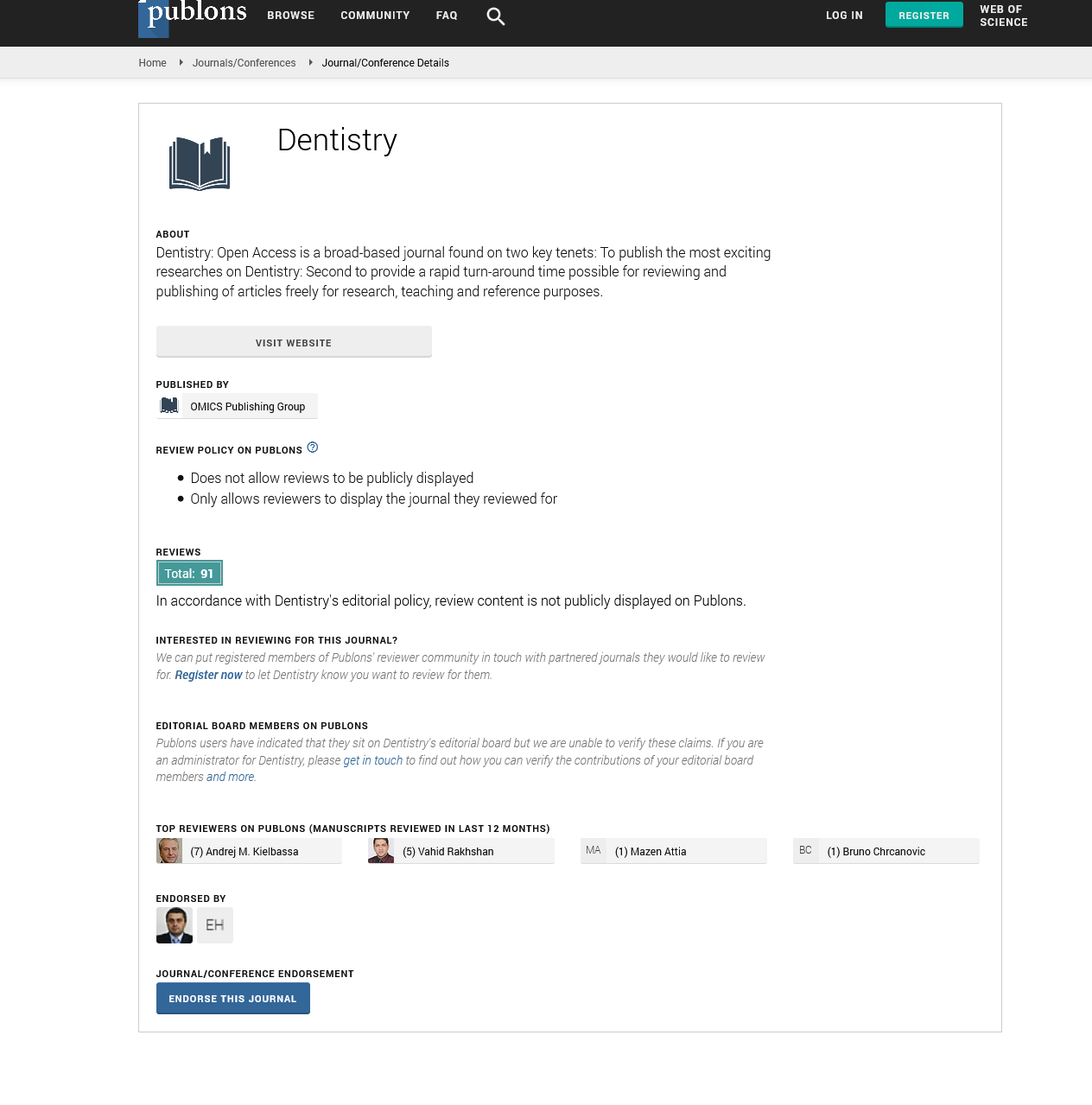Citations : 2345
Dentistry received 2345 citations as per Google Scholar report
Indexed In
- Genamics JournalSeek
- JournalTOCs
- CiteFactor
- Ulrich's Periodicals Directory
- RefSeek
- Hamdard University
- EBSCO A-Z
- Directory of Abstract Indexing for Journals
- OCLC- WorldCat
- Publons
- Geneva Foundation for Medical Education and Research
- Euro Pub
- Google Scholar
Useful Links
Share This Page
Journal Flyer

Open Access Journals
- Agri and Aquaculture
- Biochemistry
- Bioinformatics & Systems Biology
- Business & Management
- Chemistry
- Clinical Sciences
- Engineering
- Food & Nutrition
- General Science
- Genetics & Molecular Biology
- Immunology & Microbiology
- Medical Sciences
- Neuroscience & Psychology
- Nursing & Health Care
- Pharmaceutical Sciences
Commentary Article - (2024) Volume 14, Issue 4
Dental Interventions for Cancer Patients Undergoing Radiation Therapy
Yi Ming*Received: 25-Nov-2024, Manuscript No. DCR-24-27042; Editor assigned: 27-Nov-2024, Pre QC No. DCR-24-27042 (PQ); Reviewed: 11-Dec-2024, QC No. DCR-24-27042; Revised: 18-Dec-2024, Manuscript No. DCR-24-27042 (R); Published: 26-Dec-2024, DOI: 10.35248/2161-1122.24.14.707
Description
Head and neck cancer patients undergoing radiation therapy often face a range of challenging side effects, among which severe oral mucositis is particularly notable. Oral mucositis is a painful inflammation of the mucous membranes lining the mouth, which can significantly impact a patient’s quality of life. Effective dental management prior to initiating radiation therapy plays a vital role in mitigating these adverse effects and improving patient outcomes.
Understanding oral mucositis
Oral mucositis is a common complication in patients receiving radiation therapy for head and neck cancers. The condition manifests as painful sores and inflammation in the oral mucosa, which can severely impair a patient’s ability to eat, speak and maintain oral hygiene. It results from the damage to rapidly dividing cells in the mucosal lining caused by radiation, leading to symptoms that can include erythema, ulceration and discomfort.
The severity of oral mucositis often correlates with the radiation dose and the specific area being treated. The condition can become so severe that it necessitates a temporary cessation of therapy, thereby impacting the overall treatment plan and prognosis.
The role of dental management
Effective dental management prior to the commencement of radiation therapy is essential for minimizing the risk and severity of oral mucositis. This proactive approach involves several key components.
Comprehensive oral examination: Before starting radiation therapy, a thorough dental examination is essential. This examination helps identify any existing oral health issues, such as dental caries, periodontal disease, or infections, which could be exacerbated by radiation therapy. Addressing these problems before treatment can reduce the risk of complications and improve overall oral health.
Dental restoration and treatment: Any dental issues discovered during the pre-radiation examination should be addressed promptly. This may include repairing or extracting decayed or damaged teeth, treating gum disease and ensuring that any potential sources of infection are managed. Properly restored and healthy teeth and gums are less likely to be adversely affected by radiation therapy.
Oral hygiene instruction: Patients undergoing radiation therapy are at increased risk of oral infections and mucositis. Educating patients on maintaining optimal oral hygiene is a fundamental aspect of pre-radiation dental care. This includes instruction on effective brushing techniques, flossing and the use of fluoride treatments to strengthen enamel and prevent decay.
Nutritional counseling: Patients with severe oral mucositis often experience difficulties with eating. Providing nutritional counseling and recommending soft, non-irritating foods can help patients maintain adequate nutrition during treatment. Additionally, advising on proper hydration and the use of saliva substitutes can alleviate some of the discomfort associated with mucositis.
Preventive measures: Dental professionals can implement preventive strategies to minimize the risk of mucositis. This may include applying protective agents to the oral mucosa, such as topical anesthetics or barrier coatings, which can reduce irritation and discomfort. Additionally, fluoride treatments can help protect teeth from radiation-induced damage.
Custom-fitted appliances: In some cases, custom-fitted oral appliances, such as mouth guards, can be used to protect the mucosa from irritation caused by radiation therapy. These appliances can help reduce the impact of radiation on the oral tissues and provide relief from discomfort.
Managing severe oral mucositis during treatment
Despite the best preventive efforts, some patients may still develop severe oral mucositis. In such cases, effective management strategies are essential to alleviate symptoms and support the patient’s overall well-being:
Pain management: Controlling pain associated with oral mucositis is critical for maintaining patient comfort and quality of life. This may involve the use of analgesic medications, including topical anesthetics and systemic pain relievers, as well as maintaining good oral hygiene to prevent secondary infections.
Treatment of oral infections: Patients with oral mucositis are at increased risk of secondary infections, such as fungal infections. Prompt diagnosis and treatment of these infections with appropriate antifungal or antibiotic therapies are necessary to prevent complications and promote healing.
Hydration and nutritional support: Ensuring adequate hydration and providing nutritional support is essential for patients with severe mucositis. This may involve recommending high-calorie supplements, using enteral feeding if necessary and providing guidance on how to manage pain while eating.
Regular follow-up: Ongoing dental care during radiation therapy is important for monitoring the patient’s oral health and managing any complications that arise. Regular follow-up appointments allow dental professionals to adjust treatment plans as needed and provide support throughout the course of radiation therapy.
Citation: Ming Y (2024). Dental Interventions for Cancer Patients undergoing Radiation therapy. J Dentistry. 14:699.
Copyright: © 2024 Ming Y. This is an open-access article distributed under the terms of the Creative Commons Attribution License, which permits unrestricted use, distribution, and reproduction in any medium, provided the original author and source are credited.

